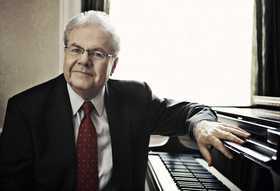|
Back
Monumental Sounds Houston
Jones Hall
10/16/2015 - & October 17, 18, 2015
Charles Ives: Symphony No. 2
Johannes Brahms: Piano Concerto No. 2 in B-flat Major, Op. 83
Emanuel Ax (piano)
Houston Symphony, Andrés Orozco-Estrada (conductor)

E. Ax (© Lisa Marie Mazzucco)
The Houston Symphony's series of Charles Ive's four incredible symphonies came to its sophomore outing in a bold, brassy performance that bodes well for the remaining two works. Andrés Orozco-Estrada gave a charming introduction to the work, replete with audio examples of several of the tunes Ives used in the piece. What was most telling was when Orozco-Estrada mentioned that the tunes were mostly unfamiliar to him, as they likely are to most non-Americans, but that the piece's construction around those tunes still communicates.
Much of Ives' orchestration seems drawn from Dvorák, with lush chordal voicing, intriguing woodwind solos and daring horn passages. The opening string passage blossomed magically and was followed by a wonderfully-paced second movement, the brass playing gloriously near the coda. Foreshadowings of Brahms came not only in the cello solo of Ives' third movement, but in the reworking of Brahms' First Symphony in the fourth. Orozco-Estrada was careful not to highlight quotations and allusions too much, placing original and borrowed material on equal footing. The cacophonous final chord brought excited giggles from the audience, who seemed to enjoy Ives' quirky creation.
Emanuel Ax's pianism is always a joy to hear, as is Brahms' monumental Second Concerto. Ax and Orozco-Estrada gave a brief preview of the piece, after which the performance was largely convincing. A slight mixup at the first movement's recapitulation and occasional phasing problems in the second movement were overcome by Ax's poetry in the Andante and the entire ensemble's combined lilt and energy in the finale. Orchestral highlights also came in the Andante, with Brinton Averil Smith again contributing fantastic tone and phrasing to his cello solos, the passage for two clarinets and piano near the recapitulation was remarkably nostalgic. Ax clearly enjoyed his repartee with Smith, the two joining together for an encore, a gorgeous rendition of the first movement of Robert Schumann's Fantasiestücke, Op. 73.
Marcus Karl Maroney
|